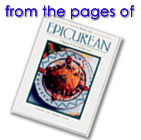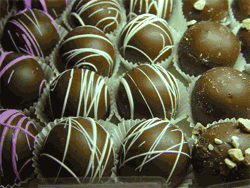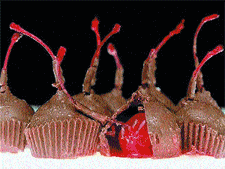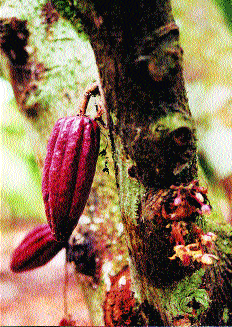
 |
|||||
|
|
|
|
|
|
|

|
|

With current heightened interest in gourmet-quality chocolate, the miraculous cacao bean deserves renewed adulation. In today's civilized society, one food continues to symbolize exquisite taste, celebration and romance: chocolate. A celestial substance brought to life by human ingenuity and expert artisanship, the handmade chocolate product-food or beverage-is the culmination of a meticulous, multi-stage process. From the initial harvesting of the cacao tree to the extraction of cocoa powder to the creative science of the organized factory, the result is commercial ambrosia. Willy Wonka is alive and well. Superior in quality and sheer chocolateness to most of the mass-produced output of the giant chocolate factories, fine quality chocolate is more likely to be created in small batches, painstakingly made, without preservatives and artificial flavors, from the very best (and pure) ingredients in smaller virtuoso shops and kitchens. Today, for example, "Chocolate lovers are looking for the intense taste, slightly increased bitterness and less sugar that dark chocolate provides," says Joseph Schmidt, San Francisco master chocolatier, usually from specialty chocolate makers who concentrate on a limited number of products. The miracle bean of the cacao tree has specific needs, growing only in tropical regions of the world within 20 degrees north and south of the equator. It needs moisture, hot temperatures and a canopy of shade in order to thrive, especially during the first few years of growth. Most of the world's cacao trees grow in West Africa, particularly in the Ivory Coast region. Other areas include Indonesia, South America, Hawaii and Central America. The cultivated tree is about 15 to 20 feet tall, bearing fruit in 5 to 6 years in the form of tough, football-shaped pods hanging from the trunk and thick branches. After the pods develop and ripen, they are harvested semi-annually. (Both the tree and its fruit are referred to as cacao, but the chocolate-potent beans are called cocoa beans.) The cocoa pods are harvested one by one, cut from the tree, opened and divested of their pulp and beans. Each pod contains 35 to 40 beans, and it takes about 200 beans to make a single pound of chocolate. The beans are placed in a basket or box and taken to the fermentation site on the farm or plantation. The fermentation process is a "crucial step in creating chocolate's flavor precursors," explains Philip Keeney (Food Sciences Dept., Penn State Univ.). Compounds are broken down during fermentation as special flavors and aromas develop. When the beans are ready for drying, they are spread on wooden trays or bamboo mats in the sun and stirred periodically until most of their moisture is released. Finally, the beans are put into sacks for transport to waiting processors around the world. Several forms of chocolate exist. Unsweetened chocolate is dark, bitter and brittle, inedible as is, but once baked it is intensely flavorful. Partially sweetened chocolate (also called bittersweet or semisweet) generally has half the amount of chocolate solids that unsweetened does. Fully sweetened chocolate (called sweet chocolate if dark and milk chocolate if light) has more sugar and less chocolate solids. (Obviously, milk chocolate contains milk.) Cocoa powder is unsweetened chocolate that has about 75 percent of its fat (cocoa butter) removed. White chocolate isn't chocolate at all but sweet, vanilla-flavored fat.
Lost in antiquity is the proof that the vanished Incas of Peru first "invented" chocolate, but there is little doubt that the Mayan Indians over 2,000 years ago created a beverage from ground cocoa beans blended with water, vanilla, black pepper and assorted spices. The liquid mixture was used during betrothal and wedding ceremonies, one of the first records of the association of chocolate and romance. It was also used for money.

Later, the Aztecs led by Montezuma II accumulated vast storehouses of cocoa beans, from which they made a drink called, "Cacahnuatt." In 1519, Spanish explorer Hernando Cortez took some cocoa beans back to Spain where a similar drink was heated with sugar, probably the first known cup of hot cocoa. By the mid 1600's, the drink was praised as delicious and health-promoting and soon gained popularity in France, then on to London as the first hot chocolate shop opened there. Chocolate houses became common in England by the 1700's. Innovations continued. The steam engine soon mechanized cocoa bean grinding which reduced production costs, making chocolate affordable to most people. The first chocolate factory opened in this country in 1765 in the Massachusetts Bay Colony. A major step forward in appeal was begun when Swiss candymaker Daniel Peter first combined condensed milk with chocolate liquor ( a non-alcoholic product from crushed beans) yielding milk chocolate, one of today's mainstay confectionery products. Although begun in Switzerland, the milk chocolate process was perfected in England. Over the years, the naturally bitter chocolate has been variously altered and embellished to give us so many degrees and kinds of sweet chocolate.
CHOCOLATE MAKING, A PRECISE PROCESS: The commercial output of handmade chocolate products, usually at a higher price than lesser quality chocolate, is an exacting process necessitating scrupulous quality control by workers who care about the worth of the finished product. Chocolate is an emulsion with acute sensitivity to heat and moisture, requiring devoted attention and knowhow as art and science are melded. Each chocolate chef guards proprietary formulas of time intervals, temperature controls and varying proportions of ingredients. After the dried beans are shipped to the foreign chocolate plants, they are cleaned and roasted, then shelled. Shattered first into nibs (large fragments), the beans are crushed between heavy steel disks (conching) where heat and grinding pressure liquefy the cocoa butter, producing a thick, dark paste(called chocolate liquor, then collected for the chocolate manufacturing process. This liquor is poured into molds where it solidifies into pressed cakes of unsweetened or bitter chocolate and cocoa powder. Cocoa is made by removing some of the cocoa butter, but eating-chocolate (dark, bittersweet or milk chocolate) is made by adding it. The added cocoa butter enhances flavor and makes the chocolate fluid; milk, sugar, vanilla and lecithin are usually added. |

HEALTH ISSUES: Cocoa powder is even higher, containing seven times the amount of antioxidants found in the beans. In addition, chocolate possesses a surprising number of other beneficial substances including cocoa butter (shown by French studies to counteract cholesterol), calcium, potassium, sodium, magnesium, iron, riboflavin, theobromine and vitamins A through E. Of course, excessive consumption of chocolate (or any single food) is not a healthy practice whether or not it involves sugar, salt and saturated fat. Purists know the beneficence of cocoa butter. It not only gives chocolate its uniquely smooth texture; despite its high saturated fat content it also does not raise cholesterol, apparently, because of the presence of stearic acid. Some low-grade chocolate concoctions, however, are potentially injurious. Chocolate blends use large amounts of sugar while substituting palm oil, shea nut butter or other vegetable or animal fat instead of cocoa butter. "Some even contains vanillin, a synthetic flavor chemically derived from wood chips," says Carol Anderson, researcher/writer for THE CALIFORNIAN. The "pre-melted" liquid chocolate, packaged in foil packets meant to replace a square of unsweetened chocolate, is not true chocolate but a combination of cocoa powder and vegetable oils. It doesn't taste the same as whole chocolate; nothing does. Only a limited number of chocolatiers have the mix of attitude and performance which contributes to the production of superlative handmade chocolate. Such an example who ranks among the best in the nation is a specialty candymaker in Salem, Massachusetts: Harbor Sweets, founded by Ben Strohecker. (His factory is relatively small compared to the multi-product manufacturers who make a variety of items which often includes baker's chocolate, cocoa mix, chocolate syrup, pudding, frosting mix, candy, cakes, cookies, etc.). Strohecker is the embodiment of Willy Wonka, making handmade chocolate candy since 1974 and selling it at luxury prices to customers who are pleased to pay it. His specialty chocolates are Marblehead Mints (sweet dark chocolate flavored with peppermint), Barque Sarah ( milk chocolate and toasted almonds), Sweet Shells (dark chocolate spiced with orange), Sand Dollars (pecan halves wrapped in butter carmel and dark chocolate), Sweet Sloops (Strohecker's flagship candy of almond butter crunch), Periwinkles (smooth milk chocolate) and some peanut butter and milk chocolate blends. They constitute what is perhaps "the most expensive handmade chocolates in the world," says Strohecker. The old dictum of 'you get what you pay for,' applies. Ben Strohecker's stated philosophy is no mere public relations puffery but an actual working mechanism in his mind and the minds of his employees. Along with his new president/owner, Phyllis LeBlanc, the driving philosophy is "to serve the employees and customers, not stockholders," he says. The majority of his 140 employees work part-time (20 hours a week) "choosing which four-hour shifts best suit their personal schedules, as well as the particular job each would like to do-dipping, culling, wrapping or molding, for example. "Our only rule," he explains, "is if you're not having fun, you're fired." Surprisingly, Ben has no secrets from them. "The monthly profit/loss statements are posted next to our time clocks," he adds. "Trust is what runs Harbor Sweets." LeBlanc started at Harbor Sweets over 21 years ago as a dipper while a student at Salem State College and persisted later as a Master's student while still working. Today, she works with Ben various hours each day, as he gives advice. Her continued emphasis on the highest quality, "using no artificial ingredients, no synthetic flavors and absolutely no shortcuts keeps Harbor Sweets' chocolates in the very expensive category, priced by the piece rather than by weight," she explains. LeBlanc perpetuates Strohecker's belief that if you care about your customers getting their money's worth with genuinely luscious chocolates, you will care about the precise steps in the process to achieve that goal, and you will care about your employees. It will all fall in place. Eating a chocolate dessert or a piece of chocolate candy might be considered a relatively trivial act in a society struggling with a number of unsolved social, political and economic problems, yet it is more civilized than indulgent in a not-quite-civilized world. Silly Willy Wonka, to think that the product of the cacao tree could influence the course of human happiness. But it does-in its own proportionate way, nothing quite compares to the pleasure of chocolate. 
|
| |||